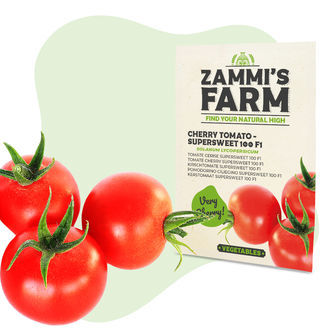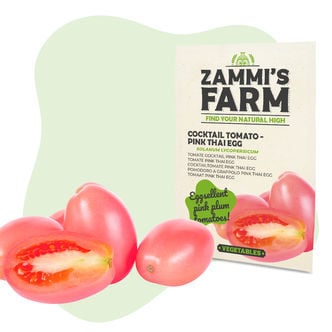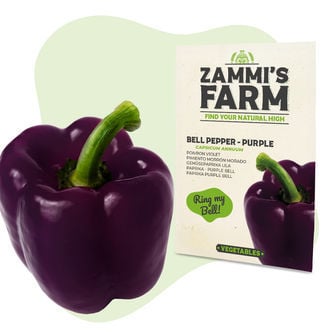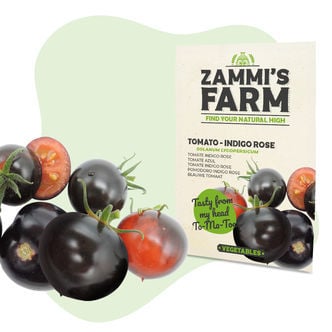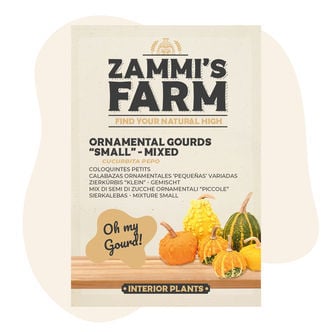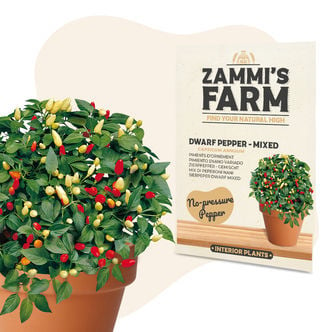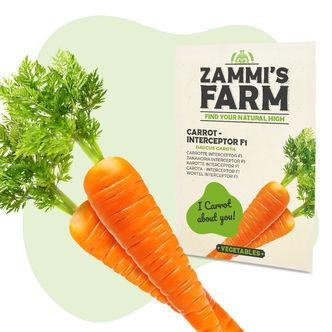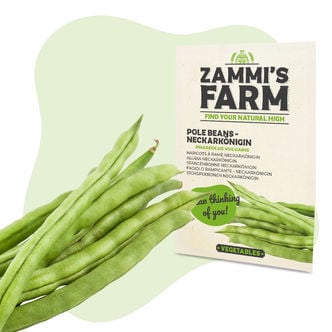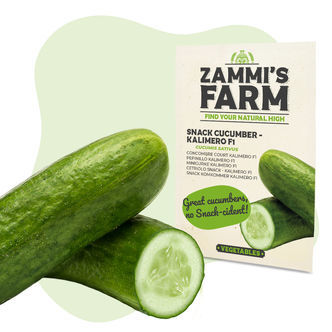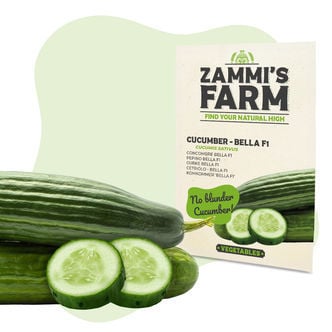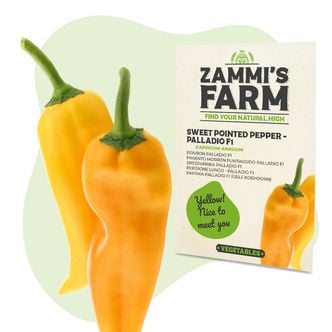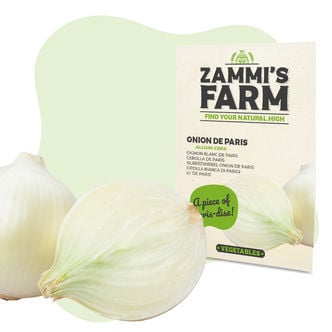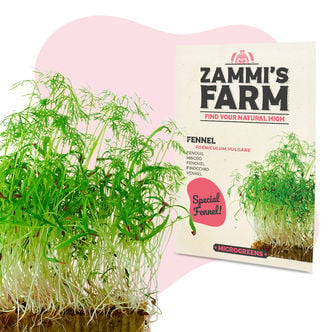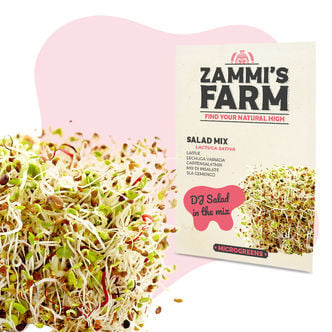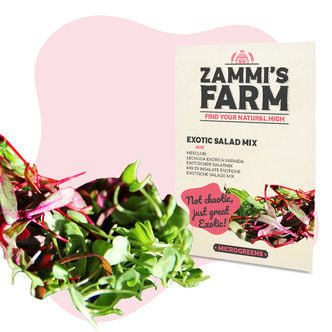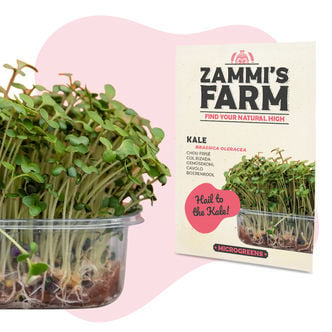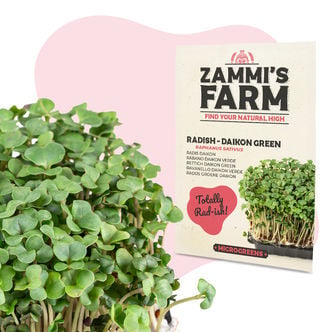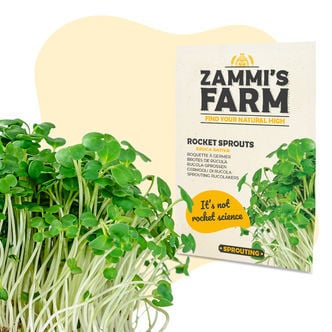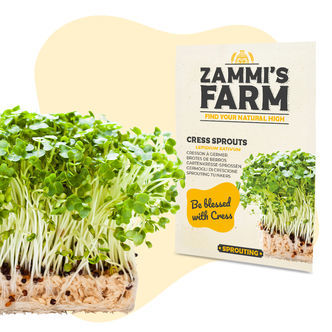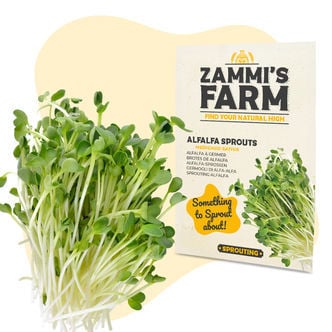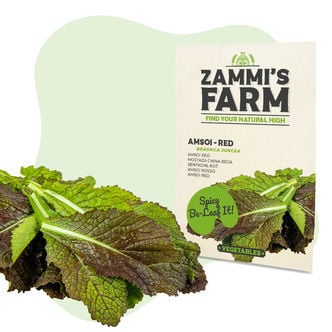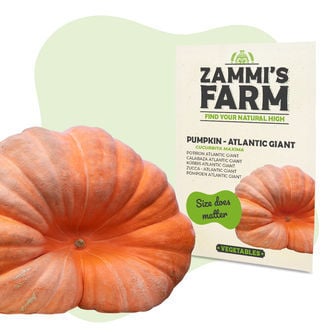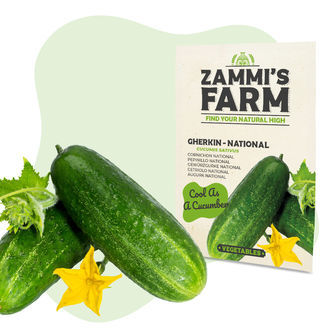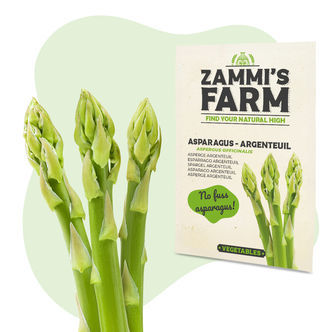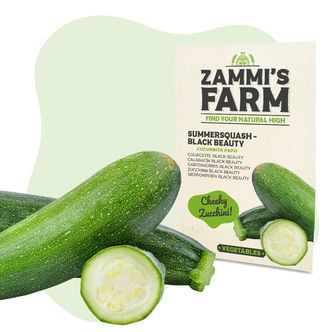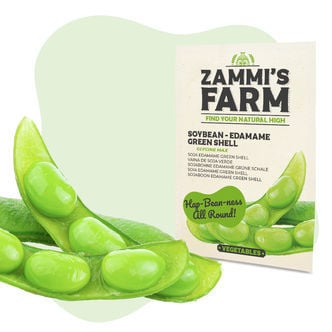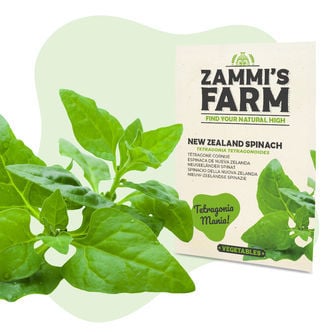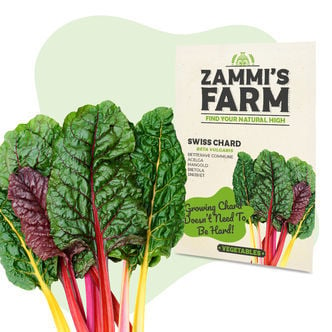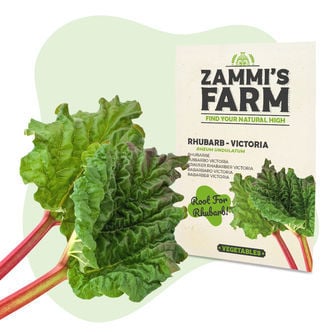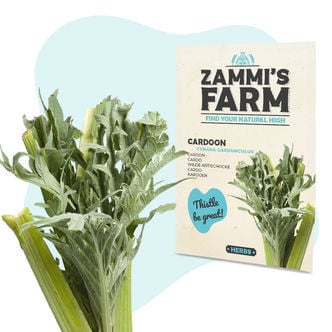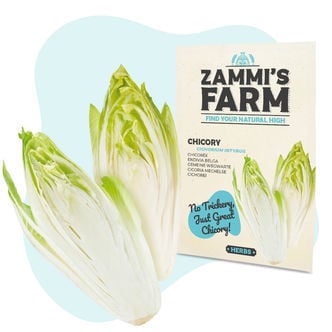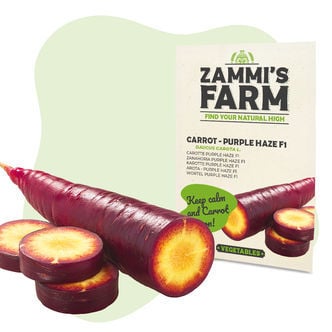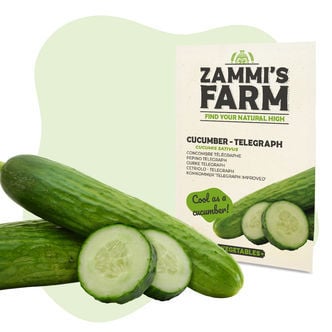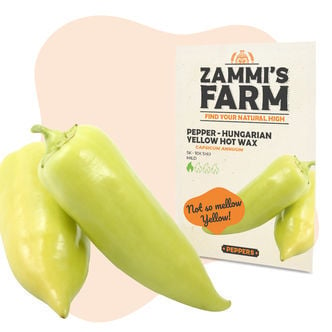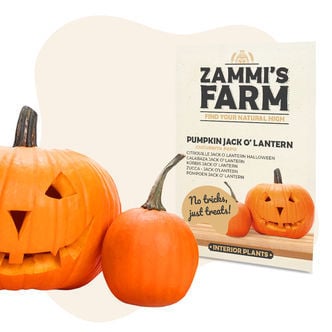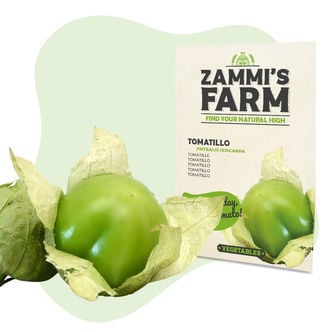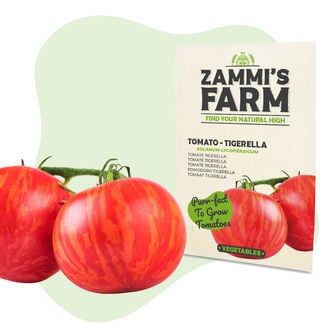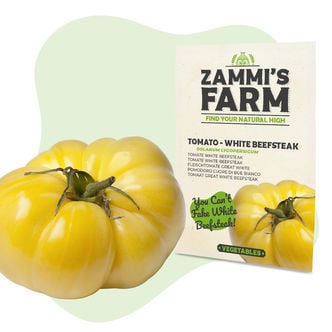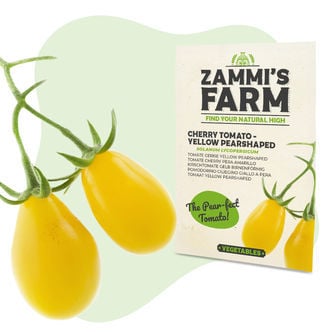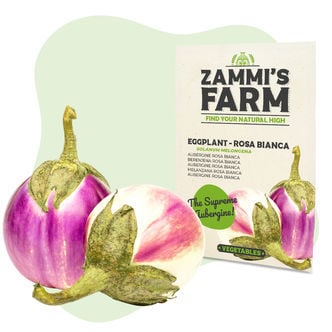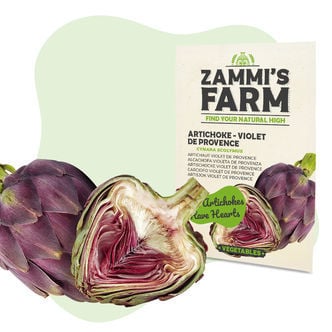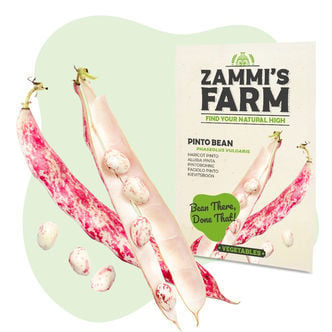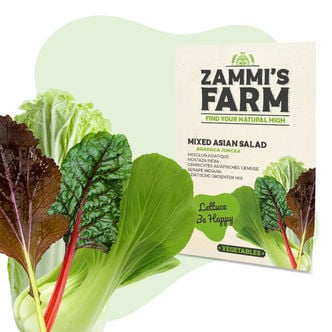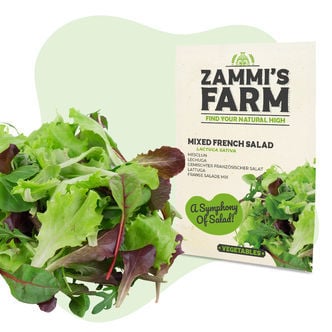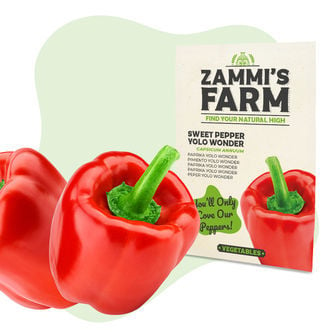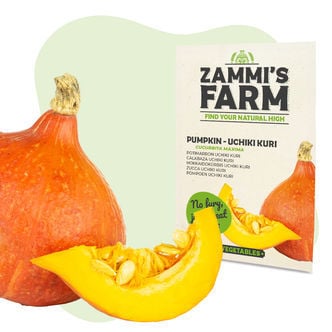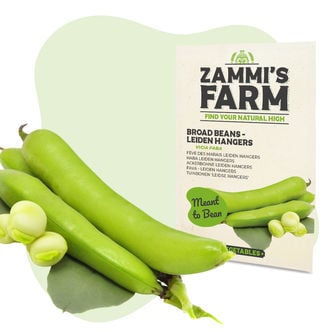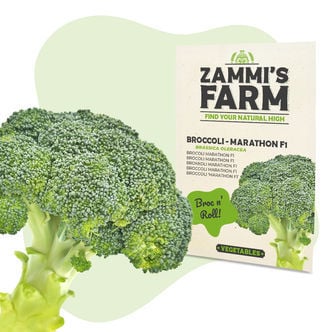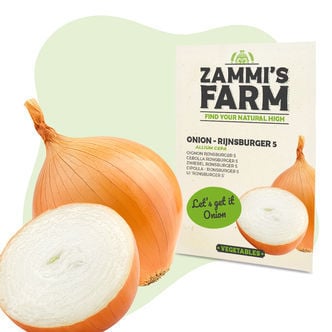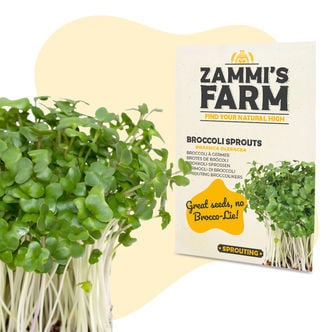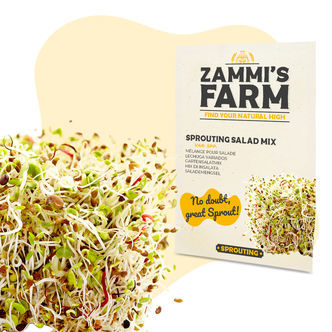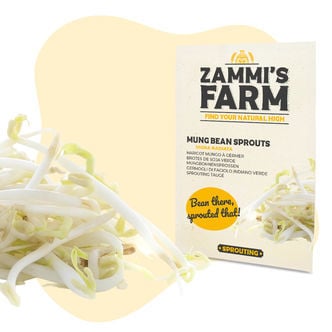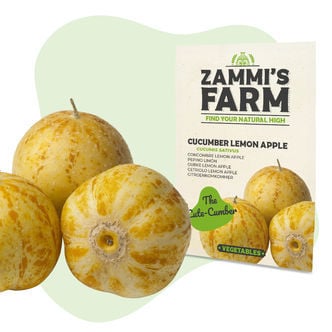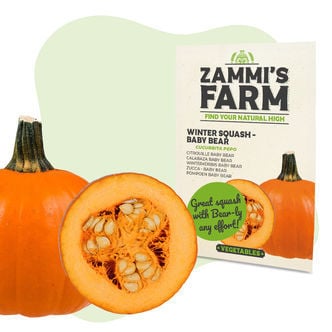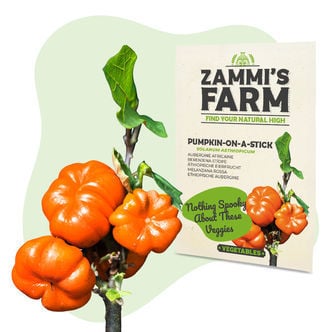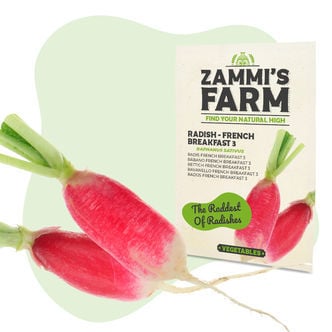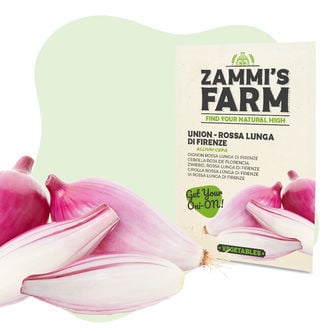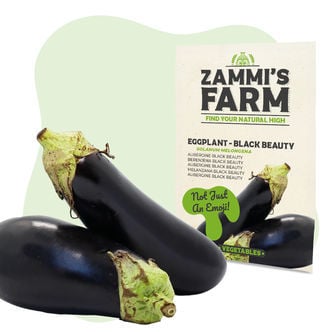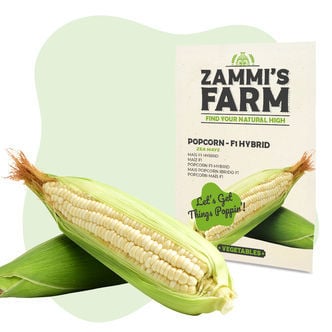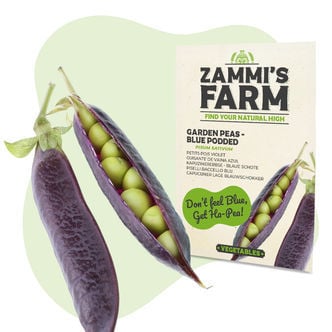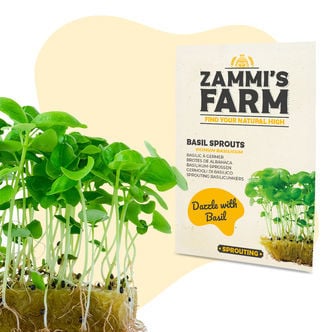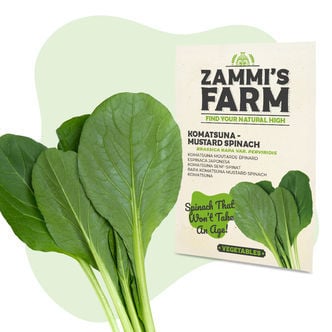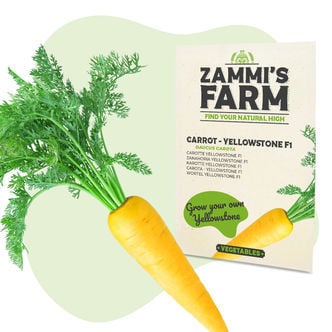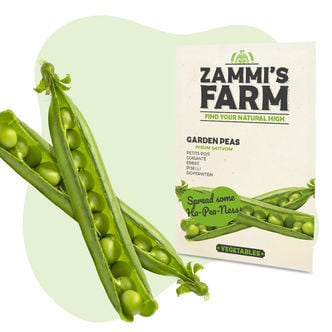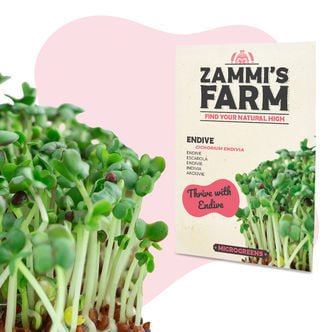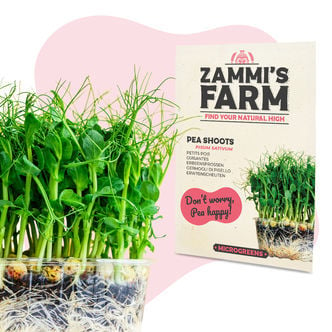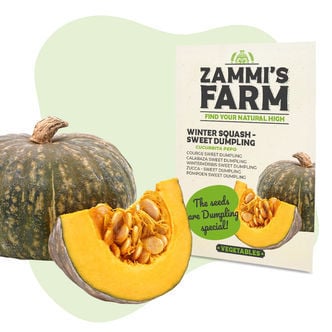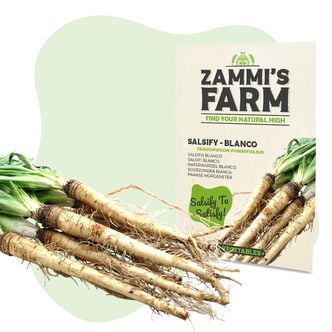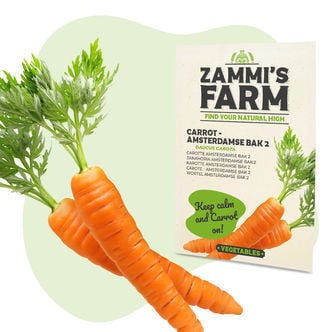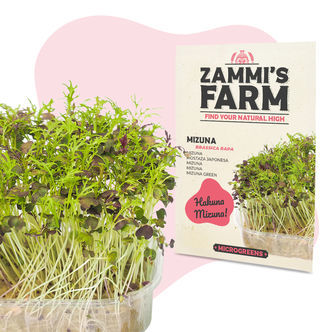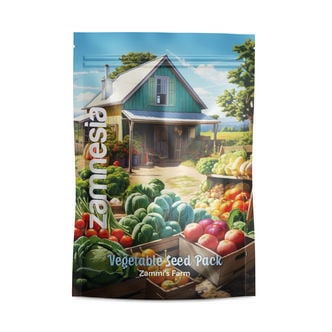Vegetable Seeds
There are 74 products.Ever wanted to grow your own supply of fresh vegetables, but thought it was too tall of an order? Well, at Zamnesia, we've got you covered. Here you'll find a full range of vegetable seeds that are just waiting to flourish in your garden, greenhouse, or balcony. That's right; you don't need acres of land to cultivate great-tasting vegetables. While you can go to your local supermarket and pick up plenty of veggies, do you really know how they were cultivated? Gain complete control over how your vegetables grow, and feel the immense satisfaction of your own handiwork.
Our vegetable seeds cater for all kinds of environments and settings. So, whether you're brand new to the home growing game or have vast experience, there's a seed for all. If you want an easy ride or a challenging plant to grow, the results are the same—high-quality fresh produce that you can be proud of!
Cherry Tomato 'Supersweet 100 F1' (Solanum lycopersicum) Seeds
The Supersweet 100 cherry tomato hybrid is one of those plant hybrids that says it all in its name: these plants produce extremely sweet fruit and, in the right conditions, can grow into long vines capable of producing 100 or more tomatoes at once. Note that this is a tall tomato variety that needs full sun, support from stakes/trellises, plenty of care, and a lot of natural fertilizer to thrive.
Cocktail Tomato 'Thai Pink Egg' (Solanum lycopersicum) Seeds
Thai Pink Egg Tomatoes originate from Thailand where they're treasured for their bright colour and deliciously sweet flesh. While they grow very similarly to other tomato (Solanum lycopersicum) varieties, Thai Pink Egg tomatoes like a little more water than usual, and hold up better in rainy climates as well as heat waves. Remember to prune and fertilize tomatoes regularly for bountiful harvests.
Paprika Purple Bell (Capsicum annuum) Seeds
Add some vibrant violet colours to your garden! Paprika Purple Bell is the way to go. Get these seeds sown and started under glass between March and May, and you'll be greeted with a bevvy of purple peppers come summertime. Just house them in moist soil with a consistent temperature of around 20-25°C; you can't go wrong. With sweet flavours, they make the perfect addition to all kinds of dishes.
Indigo Rose Tomatoes (Solanum lycopersicum) Seeds
Indigo Rose is a heirloom tomato variety (Solanum lycopersicum) that produces stunning purple/black fruit. Like other tomato varieties, Indigo Rose is best grown in full sun and highly fertile soil, regularly pruned/pinched, and supported with stakes/towers/trellises. Harvest when the shade-facing side of the tomatoes are a soft pinkish-red colour and the sun-facing side a deep purple/black.
Small Ornamental Gourds Seed Mixture
Ornamental gourds are beautiful decorations, ideal for flower arrangements, centrepieces, and more. With this seed mix, you can grow a wide variety of ornamental gourds at home with ease. Simply sow seeds in spring directly in the ground. If need be, you can transplant plants after 5-6 weeks. Remember to slowly dry the harvested fruits for long-lasting, beautiful gourds.
Dwarf Pepper 'Mixed' (Capsicum annuum) Seeds
Add some colour to your home! These peppers aren't really suitable to eat due to their acquired taste that isn't super flavourful. But what they lack in flavour, they more than makeup for their outstanding appearance. Simply pot these seeds indoors in February and let them flourish throughout the year as they showcase massively appealing red and yellow colours, brightening any space.
Carrot - Interceptor F1 (Daucus carota) Seeds
These slimline carrots make for a healthy snack and have a sweet, satisfying taste. What's more, is that these seeds are effortless to cultivate and are unlikely to give even the most novice of growers a hard time. Sow these seeds directly into the ground and provide them with a little maintenance and upkeep and they'll deliver a bevvy of bright orange beauties come July-October. Perfect.
Pole Bean Neckarkönigin (Phaseolus vulgaris) Seeds
For an effortless growing project, look no further than Pole Bean Neckarkönigin (Phaseolus vulgaris). Sow these seeds directly into the ground in mid-May and let them do their thing. All it takes is a little maintenance, sunlight and moist soil, and this plant will perform. Able to produce plenty of veggies with very minimal effort makes Pole Bean an excellent choice for all growers.
Kalimero F1 Snack Cucumber (Cucumis sativus) Seeds
Whether pickled, as part of a salad or just a healthy treat, our Kalimero F1 Snack Cucumber is an incredibly simple veg to cultivate, not to mention extremely fast too! Get them going indoors around March and bring them outside for them to flourish over Summer. They're so quick to grow that you can actually get a few harvests from the same plant at the end of Summer. Versatile and accessible!
Cucumber Bella F1 (Cucumis sativus) Seeds
Bella F1 cucumber seeds (Cucumis sativus) produce long, sweet, and crisp fruit and are resistant to mildew. Start seeds outdoors in early-mid Spring and remember to water your plants generously while taking care not to wet their leaves (which attracts moulds and other pathogens). Use trellises to support the long vines and save space, and enjoy continuous harvest all throughout summer.
Sweet Pointed Pepper Palladio F1 (Capsicum annuum) Seeds
Get these bright yellow beauties going from mid-March, and give them plenty of light, sun and moist soil, and they'll flawlessly perform. These sweet and mild peppers will be ready come late Summer. They require very little in the way of maintenance and are extremely versatile. Whether you add them to salad, tacos or any other savoury dish, these yellow peppers are sure to brighten your plate.
Sweet Pointed Pepper Kapiya (Capsicum annuum) Seeds
Looking for something genuinely vibrant both in colour and flavour? Allow us to introduce the Sweet Pointed Pepper Kapiya. It's believed this pepper is originally from Bulgaria but has been used widely throughout Europe and the rest of the world. Sow these seeds in early Spring and repot as soon as the first leaves appear. Move the plants outside and let them flourish until October.
Onion de Paris (Allium cepa) Seeds
How do you get your hands on some great-tasting onions? Easy, simply sow these seeds in early Spring under glass and then move them outside in late April. This will give them plenty of time over the summer to mature and be ready for the picking! These onions are perfect for pickling or including as tiny veg on your plate or as part of a summer salad. The options are plentiful, and so is the yield!
Microgreens Fennel (Foeniculum vulgare) Seeds
Peppery, mild and sweet, Microgreens Fennel takes just 7-14 days to germinate and just another 2 weeks on top until the earliest greens are ready to harvest and use in a multitude of dishes. Just provide them with plenty of light and warmth and keep the surrounding soil moist, and you simply can't go wrong! This is one fast-to-grow plant that delivers in all areas. Get some in your home today!
Microgreens Salad Mix (Lactuca sativa) Seeds
With a selection of great greens available here, the vibrant Microgreens Salad Mix is ideal for adding to salads and can actually be grown all year round. Quick to flourish, sow the seeds when it works for you; just be sure to keep the soil moist but not waterlogged, and this plant will deliver delicious, moreish leaves and work perfectly in plenty of dishes. Ideal for all growers!
Microgreens Exotic Salad Mix - Seeds
Take your salad game to the new level with Exotic Salad Mix. It's really easy, just scatter the seeds on top of the soil and press gently. Cover with a thin layer of soil and spray with water. Use the mister once or twice a day to keep soil most. Harvest after 2–3 weeks, when you see the first set of true leaves. Microgreens thrive in sunny environments, think windowsills or balconies.
Microgreens Kale (Brassica oleracea) Seeds
Kale (Brassica oleracea) is in the spotlight for being one of the most nutritious greens on the market. But did you know that kale sprouts are even more packed with nutrients than fully mature kale plants? Sow kale seeds in a propagator at high density, and harvest your sprouts after 7–10 days for a fresh, delicious, and highly nutritious microgreen.
Microgreens Radish - Daikon Green (Raphanus sativus) Seeds
Green Daikon Radish is delicious and highly nutritious, used typically as a garnish in Japanese cuisine. Daikon Green Microgreens, however, are just as packed with flavor yet with much higher nutrient density. To grow them, simply sow seeds at a high density in a propagator and harvest the sprouts after roughly 1 week. With a fresh, tangy flavour, they go great in fresh and cooked Asian dishes.
Rocket Sprouts (Eruca sativa) Seeds
The peppery leaves of Rocket Sprouts make for the ideal addition to a wide variety of dishes; what's more, is that the path to this tasty produce is an extremely easy one, regardless of your prior expertise! Rocket Sprouts can be grown in indoor, outside, and greenhouse settings and require very little in the way of maintenance. Sow seeds in early Spring and enjoy great flavours come Summer.
Cress Sprouts (Lepidium sativum) Seeds
Cress Sprouts make for an easygoing and hugely rewarding growing project. Whether situated on a windowsill or as part of your garden, it'll perform with very little maintenance required. This is a fast-growing plant that can be sown and grown all year round. Just be sure to provide temperatures of around 20-22°C and a little upkeep, and you can enjoy tasty cress rich in vitamins A, B and C.
Alfalfa Sprouts (Medicago sativa) Seeds
It takes about 5 days to grow alfalfa sprouts. Use a sprouting jar, soak the seeds in cool water for 8–10 hours, drain well. Spread seeds out in the jar and leave for 10 hours at room temperature, away from direct light. Repeat the rinse/dry process until sprouts reach preferred size. Alternatively, place sprouts between damp paper towels after soaking. Add to salads, sandwiches, or stir-fries.
Amsoi Red (Brassica juncea var.rugosa) Seeds
Amsoi, also known as Indian Mustard, has a spicy flavour making it ideal for use in salads and Asian cuisine. Able to be cultivated in both indoor and outside environments, amsoi is highly resilient and can withstand frost and colder climes effortlessly, making it a great choice for all levels of growers. Quick to grow and can be harvested many times.
Atlantic Giant Pumpkin (Cucurbita maxima) Seeds
Try your hand at growing Atlantic Giant Pumpkin which can weigh 100kg and more. This vegetable thrives in warm and sunny spots, and you can sow your seeds indoors in mid-spring or early summer outdoors. Ensure your plants have fertile soil and are sheltered from cold winds and you will be able to sit back and watch this vigorous grower. Harvest in September/October, right for Halloween!
Cherry Tomato - Cerise (Lycopersicon esculentum) Seeds
Who doesn't love nice, fresh cherry tomatoes to enjoy? No matter the weather, you can have a bevy of bright-red beauties in next to no time. Sow seeds in early spring indoors or outside (if living in a warm climate), and they'll be ready come late summer. Give them moist soil and plenty of light and warmth, and you'll be rewarded with a great yield. Perfect for salads and all kinds of cooking.
Gherkin 'National' (Cucumis sativus) Seeds
Grow these gherkins in your garden and you'll have a fine selection of small fruits to pick from. Get them going in early April indoors or in a greenhouse, and then take them outside to plant in May. Provide them with shelter and sun, and you'll have a harvest of gherkins-goodness in no time. Perfect for pickling, they will add some flair and flavour to your food.
Asparagus 'Argenteuil' (Aspergus officinalis) Seeds
Asparagus plants might take time to get to harvest, but they are well worth the wait. Plant asparagus seeds in rows directly in nursery seed beds 4 weeks before the Ice Saints in sandy soil. Seeds can take 3 weeks to germinate, and young plants should be kept in nurseries for 1 year before moving them to their final spot. Transplant mature plant crowns into trenches, adding soil regularly.
Summer Squash 'Black Beauty' (Cucurbita pepo) Seeds
Whether you know it as courgette or summer squash, this adaptable vegetable lends itself well to all kinds of cuisines. Able to produce a huge harvest, make the most of your plants by starting them under glass, and then move them outside to flourish in the summer months. Give them the perfect balance of sunlight, warmth, and shade, and you'll be rewarded with plenty of delicious veggies.
Soybean 'Edamame Green Shell' (Glycine max) Seeds
Perfect in Asian cuisines and as a healthy snack, edamame has plenty of uses. You'll be pleased to know that it's also pretty easy to cultivate from home too! Get plants started indoors or in a greenhouse in early May, and then once the seedlings are big enough, move them outdoors to soak up the sunlight and warmth. Come October, you'll have a bevy of soybeans ready to go.
New Zealand Spinach (Tetragonia tetragonoides) Seeds
New Zealand spinach can be harvested over a long period, which makes it ideal for continual use in cooking once ready. Be sure to soak the seeds in a bowl of water overnight before sowing to make sure they germinate. Able to be sown inside in early April or plant outdoors in May-August. Provide warmth and sun and come November time, you'll be ready to enjoy all New Zealand spinach has to offer.
Red Swiss Chard (Beta vulgaris) Seeds
A robust year-round plant, Red Swiss Chard, otherwise known as Beta vulgaris, is a plant that can sprout rhubarb-like stems with leaves that can all be utilised in plenty of different culinary dishes. With a sowing period of March until July, enjoy the fruits of your labour come September/October time. With bright red colouring, this will brighten up both your garden and dinner plate.
Victoria Rhubarb (Rheum undulatum) Seeds
Victoria rhubarb (Rheum undulatum) likes sunny locations and needs exceptionally well-draining soil (waterlogging or overwatering can greatly impact the growth of rhubarb plants or cause them to rot). Rhubarb also doesn't like extremely hot conditions, which can stunt it or stop plant growth altogether. Fertilise in spring and summer for improved growth. Harvest a few stalks at a time in autumn.
Cardoon (Cynara cardunculus) Seeds
Cynara cardunculus (cardy, cardoon, or artichoke thistle) is a very hardy and somewhat invasive plant. It grows best in soil rich in organic matter (including dung and decomposing plant matter) and in locations with warm conditions and full sunlight. The spiked flowers can be eaten like artichokes, while the stalks are best protected from the sun (using dirt mounds) and served boiled or braised.
Chicory (Cichorium intybus) Seeds
Sow chicory seeds in spring, after the last frost, in a spot with at least 6hrs of direct sunlight. Take care not to bury the seeds deeper than 0.5cm beneath the soil. Seedlings will sprout after 2–3 weeks in moist (but not wet) soil and should be thinned to leave roughly 30cm between plants. Harvest fresh leaves and blanched buds to eat raw. Dried, ground chicory roots can substitute coffee.
Purple Haze F1 Carrot (Daucus carota L.) Seeds
Get yourself in a purple haze with these plum-coloured carrots! Purple on the outside and orange in the centre, these veggies are certainly eye-catching, but they're also sweet and suitable for salads, as a side or as a snack. They're versatile not just in the kitchen but in the garden too. Sow these easygoing seeds directly into the ground and let them soak up the sun and warmth until ready.
Telegraph Cucumber (Cucumis sativus) Seeds
There's nothing quite like the refreshing flavours of cucumbers. Whether added to salads or as a snack, Telegraph Cucumber (Cucumis sativus) is one versatile veg. Get these seeds started under glass from mid-March, provide some maintenance and upkeep, and come Summer, you'll have plenty of cucumbers to get your fill of. Leave around 40cm between plants and provide moist soil, and you're golden.
Hungarian Yellow Hot Wax Pepper (Capsicum annuum) Seeds
Sow your seeds in Springtime under glass and then migrate them outdoors when the time is right. Hungarian Yellow Hot Wax peppers are famously unfussy regarding maintenance and can perform well even in colder conditions, making them the ideal pepper partner for newcomers and experienced alike. Come Summer, you'll have a massive haul of moderately hot peppers that are perfect for pairing with a BBQ.
Pumpkin Jack O' Lantern (Cucurbita pepo) Seeds
Bred especially to be carved into Jack O' Lanterns, this beautiful orange, oblong Cucurbita pepo variety produces pumpkins that are very decorative yet still tasty, too. Sow your Jack O' Lantern seeds indoors in late winter, or directly outside in early spring. Like other pumpkin varieties, Jack O' Lanterns are best grown in fertile soil with stakes or trellises to accommodate their long vines.
Tomatillo (Physalis ixocarpa) Seeds
The Tomatillo or Mexican Husk Tomato dates back to the pre-Columbian era. It produces a spherical fruit with a green/purplish colour that looks similar to tomatoes but has a different flavour and texture. Tomatillo seeds are best sown indoors, and plants can be brought outside in Spring after the last frost. Tomatillo plants like well-draining soil, full sun, and regular organic fertilisation.
Tigerella Tomato (Solanum lycopersicum) Seeds
Boasting deep red skin with bright orange streaks, Tigerella tomatoes are a real sight for the eyes. This heirloom tomato variety (Solanum lycopersicum) is also very hardy and low-maintenance. Tigerella tomatoes grow well in full sun, and hold up well to mould and pests, though regular pest control is still recommended, as with all tomatoes. They produce aromatic, sweet fruit in 55-60 days.
Great White Beefsteak Tomato (Solanum lycopersicum) Seeds
The Great White beefsteak tomato is a real sight for the eyes, producing big, yellowish-white fruit. Pioneered by Thomas Jefferson in his garden in Monticello, these plants are best sown indoors 8 weeks before the last frost and brought outside once the threat of frost has passed. Grow Great White beefsteak tomatoes in full sun, fertilise regularly, and use stakes to support their heavy vines.
Yellow Pear Cherry Tomato (Solanum lycopersicum) Seeds
Besides their vibrant yellow colour, Yellow Pear Cherry Tomatoes (Solanum lycopersicum) boast a deliciously sweet, slightly acidic flavour. Sow your seeds in spring after the last frost and enjoy an endless supply of sweet cherry tomatoes all through summer. Yellow Pear tomatoes grow best in full sun and fertile soil. Fertilise plants regularly and use stakes or trellises to support their vines.
Eggplant 'Rosa Bianca' (Solanum melongena) Seeds
The Rosa Bianca eggplant variety (Solanum melongena) produces large, globe-shaped white fruit with beautiful lavender-purple streaks. Like other eggplant varieties, Rosa Bianca grows best in warm conditions and full sun. It likes fertile, moist, and acidic soil, occasional watering, and a hearty dose of phosphorus during flowering. Remember to mist plants regularly as soon as flowers appear.
Artichoke 'Violet de Provence' (Cynara Scolymus) Seeds
Not only mindblowing in the flavour department, but Violet de Provence artichokes also showcase amazing looks that make it a must for any garden. Sow the seeds indoors between February and April, and place them outside in early summer. This is a perennial plant that will just keep going as long as you need it. Easy to care for, just cover in the winter months, and it'll usually look after itself.
Pinto Bean (Phaseolus vulgaris) Seeds
Pinto bean plants (Phaseolus vulgaris) grow like all other bean varieties but produce unique speckled beans. They like moist, fertile, loamy soil and full sun. Propagate your seeds after the last frost directly, roughly 4-6cm between each seed and use a pole, stake, trellis, or fence to guide the plants as they grow. Harvest pinto beans after roughly 45-60 days and use them fresh or dried.
Mixed Asian Greens Seeds
Get your seeds sown in early March, and by the end of August, the young leaves of the greens will be ready to harvest. A versatile combination of pak choi, taisai, tatsoi, turnip greens, chard, Chinese cabbage, leaf mustard and purple frills. All of these combine great flavours in a variety of dishes. Just be sure to provide plenty of light, warmth and moist loamy soil for best results.
Mixed French Salad (Lactuca sativa) Seeds
Perfect for a light summer meal, Mixed French Salad seeds grow into a mixture of red oak leaf lettuce, endive, radicchio, frisée, and arugula. Great for salads and undeniably tasty. Sow around May, and plants will be ready come September. Grow in moist, loamy soil with plenty of light and warmth for the best results. Reaching small heights, plants are easy to manage and care for.
Sweet Pepper Yolo Wonder (Capsicum annuum) Seeds
Related to the famous California Wonder, Yolo Wonder peppers are very resistant to disease and produce an abundance of sweet, crunchy peppers. Plant Yolo Wonder seeds in full sun in well-draining, fertile soil rich in organic matter, and roughly 45–60cm apart. Water regularly and feed flowering plants with a potassium-rich fertiliser. Prune/pinch foliage on young plants to encourage bushy growth.
Exotic Seed Pack - Zammi's Farm
This pack of exotic plant seeds contains a range of seeds that will allow you to grow a weird and wonderful array of fruit and veg in your garden! If you want to grow plants that look great, and taste great come harvest time, you're in luck! Impress yourself and your friends with the Exotic Seed Pack.
Pumpkin Uchiki Kuri (Cucurbita maxima) Seeds
Uchiki Kuri, also known as Red Kuri, is a bright orange squash variety. Seeds can be sown in spring outdoors directly in seed beds. Mature plants like rich organic soil, so prepare the soil with compost or manure or fertilize regularly. Besides being very decorative, Uchiki Kuri squash boasts sweet flesh that goes great in sweet and savoury recipes.
Broad Bean Leidse Hangers (Vicia faba) Seeds
Broad beans are not only delicious but also super healthy. This fast-growing and resistant variety can be planted in early spring or fall and produce plentiful harvests of long, sweet beans filled with 5-6 pods. Blanched, stir-fried, or in soups and stews, these delicious beans make a great addition to a variety of meals. Plus, they can also be frozen fresh and keep for months in the freezer.
Broccoli Marathon F1 (Brassica oleracea) Seeds
Marathon F1 Broccoli (Brassica oleracea) seeds produce hardy plants that yield large, tender, and delicious Broccoli heads. Start your seeds in early to mid-spring for a summer crop, and in late summer for an autumn harvest. Remember that broccoli likes full sun but hates the heat, which causes it to bold and produce flowers rather than luscious heads.
Onion - Rijnsburger 5 (Allium cepa) Seeds
If there's a vegetable that has got to be a staple in every kitchen, it is the noble onion (Allium cepa). For the best results, start onions off indoors during late winter, and trim their tips when they're about 7–8cm long. Bring them outside in spring to grow in the sun till the end of summer, when they'll start focusing their energy on bulb production.
Broccoli Sprouts (Brassica oleracea) Seeds
Whether you like them in your smoothie, salad or sandwich, there's no denying the rich antioxidants and tasty flavours of Broccoli Sprouts. They're also incredibly simple to cultivate. Sow the seeds in a pot in early Spring and give them plenty of sun, warmth and a little water now and again, and they'll flourish effortlessly. Come August, they'll be ready to harvest and can be enjoyed instantly.
Sprouting Salad Mix Seeds
Jump on the bandwagon and grow sprouts at home with the Sprouting Salad Mix—healthy and delicious mung bean, alfalfa, lentil, fenugreek and yellow mustard sprouts. Grow them in a sprouting jar or one with muslin tied over the top. Soak your seeds for about 8 hours and drain thoroughly. Rinse and drain twice a day, when you see sprouts, leave in a well-lit area until they reach the desired size.
Mung Bean Sprouts (Vigna radiata) Seeds
Vigna radiata, commonly known as the mung bean, is a delicious and highly nutritious legume ideal for stewing or slow cooking. Mung bean sprouts, on the other hand, are fresh and watery, ideal for summer salads or stir-frying. Plus, growing them couldn't be easier; just sprout the beans in damp paper towels and use them when they're about 4–5cm long!
Lemon Apple Cucumber (Cucumis sativus) Seeds
Perfect for salads, the lemon apple cucumber has a slightly sweet flavour that's refreshing and moreish. All it takes is a little gardening know-how, and you'll have some fantastic fruits at your disposal. Get the seeds started under glass, and allow the plants to flourish until late summer. Then, you can harvest and enjoy the yellow, apple-shaped fruits of your labour. Delicious!
Winter Squash Baby Bear (Cucurbita maxima) Seeds
Baby Bear Winter Squash (Cucurbita maxima) is a must-have for every veggie patch. Germinate your seeds indoors and bring them outside in the spring. Plant Baby Bear squash in soil with plenty of manure or compost to ensure healthy growth and the production of large, sweet fruit. Use tutors, stakes, or trellises to grow Baby Bear Squash vertically in smaller spaces.
Pumpkin on a Stick (Solanum aethiopicum) Seeds
What can we say about pumpkin on a stick? The name is the biggest clue! These veggies are perfect for adding to cooking, as both the fruit and leaves can be eaten. However, some even opt to use pumpkin on a stick as part of a flower arrangement, giving it plenty of applications for all. Get them started early indoors, and then let them bask in the summer sun. Easy.
Radish 'French Breakfast 3' (Raphanus sativus) Seeds
Crisp and crunchy are just words to describe the French Breakfast 3 variety of radish. They offer up a great "snap" when eaten and have a fresh flavour that's perfect for blending with other vegetables. In fact, it's even recommended that these seeds are sown next to carrots or lettuce to give them a good biological balance. Begin them in March, and they'll be good later in the summer.
Onion 'Rossa lunga di Firenze' (Allium cepa) Seeds
Rossa lunga di Firenze is a unique onion cultivar originating from Tuscany, Italy. It is best sown in rows outdoors during spring in fertile, well-draining soil and full sun. Thin seedlings after 6 weeks. Where possible, keep soil pH between 6 and 6.8 (though not crucial). The "Long Red of Florence" takes approx. 4 months to mature and produces mild-flavoured, elongated onions best eaten fresh.
Eggplant 'Black Beauty' (Solanum melongena) Seeds
Whether you know it as eggplant or aubergine, one thing's for sure; this is a hugely versatile and tasty vegetable, no matter how you use it. Named Black Beauty for its dark skin, all it takes is a matter of months for ripe fruits to be ready for the picking. Start in a seed tray indoors or in a greenhouse, then move outdoors to let them thrive until harvest time in late summer.
Popcorn (Zea mays) Seeds - F1 Hybrid
Zea mays, sweet corn, or popcorn is an ancient crop that grows well in home gardens. It loves full sun and well-draining, moist, and fertile soil (preferably with a neutral or slightly acidic pH). Sow Zea mays in blocks to ensure effective wind pollination to harvest full cobs. Harvest Zea mays when the tassels at the end of the plant's cobs turn black, and use in your favourite recipes.
Blue Podded Pea (Pisum sativum) Seeds
These veggies are ideal for all kinds of dishes and deliver great flavours each time. Growing the Blue Podded Pea is also a cinch, regardless of your environment. Sow the seeds as early as February and watch as they flourish through to June-July. Once at this stage, they're ready for the picking. Just be sure to keep the soil moist but not overly and provide plenty of light. You can't lose.
Basil Sprouts (Ocimum basilicum) Seeds
Basil (Ocimum basilicum) is a beloved, highly fragrant herb. But did you know that basil sprouts are equally delicious yet much more nutritious? To grow yours, simply sow seeds at a high density in a propagator and harvest your sprouts after roughly 10 days. Use just as you would normal basil, with the same great taste but much more nutrients!
Komatsuna (Brassica rapa var. perviridis) Seeds
Komatsuna is a unique variety of Mustard Spinach (Brassica rapa), also known as Japanese Mustard Spinach. Like other spinach varieties and leafy greens, Komatsuna seeds are best sown outdoors in nitrogen-rich, moisture-retentive soil. Mulching is recommended to help the soil retain more moisture. Seeds can be sown from early spring to autumn. Harvested leaves can be eaten fresh or cooked.
Yellowstone F1 Carrot (Daucus carota) Seeds
Add some bright yellow magic to your garden with these Yellowstone F1 Carrot (Daucus carota) Seeds. Simply sow these seeds directly into the ground in March and keep the soil moist throughout their growing cycle. When August rolls around, you'll be met with a whole bunch of yellow carrots that are perfect for a wide variety of dishes and meals. What could be better than that?
Garden Peas (Pisum sativum) Seeds
Sow these delicious peas in early to mid-spring directly outdoors. These hardy plants will grow roughly 150cm tall with many tendrils, so they're best supported with trellises and stakes. Harvest your peas while they are still juicy and enjoy them fresh or cooked in everything from salads and stir-fries to soups and stews.
Microgreens Endive (Cichorium endivia) Seeds
Ideal for being added to salads, soups and a variety of dishes, the Microgreens Endive have long been used since the days of ancient Greece! Rich in vitamins K and C, you too can now enjoy the great flavours. Seeds take 2–3 days to germinate, and the earliest leaves that sprout around the 8–15 day mark are perfect for picking. Give them moist soil, some sunlight and warmth, and they'll perform.
Microgreens Pea Shoots (Pisum sativum) Seeds
To get the best out of your Microgreens Pea Shoots, simply sow the seeds in early Spring, and they'll be fast to flourish. Able to be grown in warm outdoor spaces or in a small windowsill or balcony space, keep the soil moist throughout but not waterlogged, and these sweet leaves will begin to appear pronto! Enjoy rich flavours that are ideal to accompany salads, soups and sandwiches. Perfect.
Winter Squash Sweet Dumpling (Cucurbita pepo) Seeds
Sweet Dumpling is a delicious variety of winter squash (Cucurbita pepo) with a hard, cream-coloured rind and tender, sweet flesh. Growing to roughly the size of a grapefruit, Sweet Dumpling squash make a great addition to any veggie patch. Start seedlings off indoor in late winter or directly outdoors in early spring. Like other squashes, plant Sweet Dumpling squash in highly fertile soil.
Salsify 'Blanco' (Tragopogon porrifolius) Seeds
Salsify (Tragopogon porrifolius) has long been cultivated in England, Belgium, and France. Sow salsify seeds directly outdoors, leaving 8-10cm between plants and 30-40cm between rows. Salsify likes deep, loose, and fertile soil with plenty of organic material, full sun, and regular watering (especially in warm climates). Harvest roots before plants bloom, followed by shoots and flowers.
Carrot Amsterdamse Bak 2 (Daucus carota) Seeds
Getting your hands on some sweet, delicious carrots has never been easier with our Carrot Amsterdamse Bak 2 (Daucus carota) Seeds. Start these seeds off under glass indoors in early Spring and then move outdoors so they can soak up the warmth and light that Summer provides. Just ensure they're well looked after, and they can't do you wrong. Enjoy large yields of sweet-tasting carrots come Summer.
Microgreens Mizuna (Brassica rapa) Seeds
These fast-to-flower Asian leaves can be cultivated in a wide variety of settings and environments. They are typically low maintenance and suit growers of all skill sets. Sow the seeds in early Spring and enjoy them after just a few weeks of flourishing. Microgreens Mizuna has a mustard-like flavour that's ideal for adding to salads and other dishes for a little spicy snap.
Vegetable Seed Pack - Zammi's Farm
This variety pack of vegetable seeds has everything you need to sow a vegetable patch and then harvest a bountiful array of delicious veg! Whether you want to make fresh salads or cook warming stews, there are seeds in this pack to meet all of your needs. Get growing now!













 United States
United States

